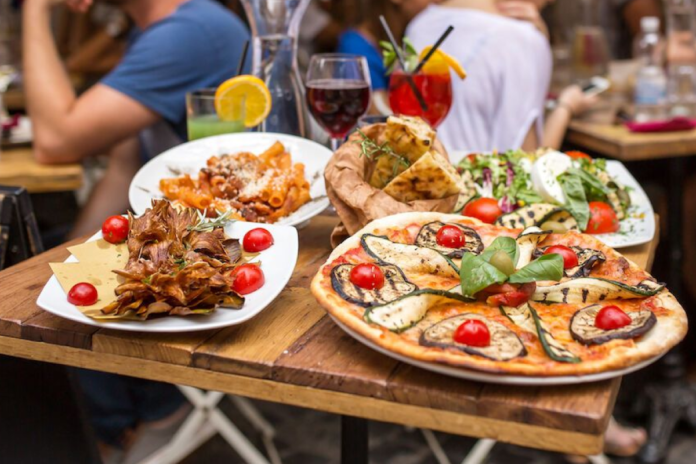Italy isn’t just a country; it’s a lifestyle, and at the heart of that lifestyle is food. Not just any food, but food that’s crafted with patience, love, and respect for ingredients and tradition. Enter the Slow Food movement, born in Italy as a response to the fast-food culture threatening the integrity of the country’s cuisine. If you’re ready to slow down, take a journey through Italian food culture, and savor every bite, keep reading. This guide will walk you through the philosophy, history, and impact of Italian Slow Food, and introduce you to some must-try dishes and experiences along the way.
What is Slow Food?
Slow Food is a global movement that began in Italy in the late 1980s as a counter-response to the rise of fast-food culture. Founded by Carlo Petrini in Bra, a small town in Northern Italy, Slow Food’s mission is to promote food that’s “good, clean, and fair”—that is, food that tastes good, is produced without harming the environment, and ensures fair wages for those who produce it. The movement celebrates traditional cooking methods, local ingredients, biodiversity, and ethical farming practices, advocating for a deeper connection between people and the food they consume.
But Slow Food is more than a set of principles; it’s a way of life that invites you to connect with local farmers, understand where ingredients come from, and savor meals as cultural expressions. It’s an antidote to the rushed, impersonal nature of fast food and has now grown into a worldwide movement with millions of followers in over 160 countries.
The Roots of Italian Slow Food
The Slow Food movement began in Italy as an act of resistance. When McDonald’s attempted to open a location near Rome’s iconic Spanish Steps, Italians were outraged. They saw it as a threat to their beloved culinary heritage. Carlo Petrini rallied locals, using the event as an opportunity to raise awareness about the importance of preserving Italy’s traditional foods and regional specialties. Thus, Slow Food was born.
Since then, the movement has focused on preserving food traditions, protecting biodiversity, and promoting sustainable agriculture. Italy’s regional cuisine is incredibly diverse, with each area having its own unique ingredients, recipes, and culinary customs. Slow Food became a way to celebrate this diversity while educating people on the cultural significance of these age-old practices.
Key Principles of Italian Slow Food
Italian Slow Food isn’t just about taking your time with a meal. It’s a holistic approach that combines taste, sustainability, and ethics. Here’s a closer look at the core principles:
- Good: Quality food that’s rich in flavor and connected to local culture.
- Clean: Food production methods that don’t harm the environment and promote animal welfare.
- Fair: Fair wages and working conditions for everyone in the food chain, from farm to table.
These principles aren’t just abstract ideas—they’re woven into the very fabric of Italian Slow Food, shaping how people grow, prepare, and consume food across the country.
Regional Italian Foods Celebrated by the Slow Food Movement
Italy’s culinary diversity is staggering, and each region has its own food traditions worth exploring. The Slow Food movement shines a spotlight on these regional specialties, helping them gain recognition and protection. Here are a few examples:
- Piedmont: Known for rich dishes and earthy flavors, Piedmont is the birthplace of Slow Food. Bagna Cauda (a warm dip made from garlic, anchovies, and olive oil) and Agnolotti (small stuffed pasta) are celebrated local delicacies.
- Emilia-Romagna: Home to some of Italy’s most famous foods, including Parmigiano-Reggiano cheese, Balsamic Vinegar of Modena, and Prosciutto di Parma. Each of these ingredients is produced through time-honored methods and carries a unique, authentic taste.
- Sicily: Sicily’s cuisine reflects its diverse cultural history. The Slow Food movement highlights dishes like Pasta alla Norma (pasta with eggplant, tomato, and ricotta salata) and Caponata (a sweet and sour eggplant stew).
- Tuscany: Tuscan food is all about simplicity and quality. Ribollita (a bread-based vegetable soup) and Bistecca alla Fiorentina (Florentine steak) are prime examples of Slow Food in Tuscany, where fresh, local ingredients are key.
The Slow Food movement helps preserve these regional dishes by working with local producers, educating the public, and protecting rare ingredients and traditional methods.
Sustainable Farming and Biodiversity: The Ark of Taste
One of Slow Food’s most ambitious projects is the Ark of Taste, a catalog of endangered food products from around the world. This “ark” includes over 5,000 foods that are at risk of disappearing due to industrial agriculture, climate change, and loss of cultural traditions. In Italy, you’ll find rare ingredients like Lenticchia di Ustica (a unique lentil variety from Sicily) and Fagiolo di Sorana (a type of bean from Tuscany) in the Ark of Taste.
The idea behind the Ark of Taste is simple yet powerful: by celebrating and promoting these rare ingredients, Slow Food can encourage more people to produce, buy, and consume them, thus keeping traditional foodways alive.
Slow Food Experiences: How to Enjoy Slow Food in Italy
If you’re traveling to Italy, there are plenty of ways to experience Slow Food firsthand. Here’s how you can make the most of your Slow Food journey:
1. Visit a Local Farm or Vineyard
Italy is filled with small, family-run farms and vineyards that welcome visitors. Spend a day learning about organic farming, see how cheese or olive oil is made, and enjoy a meal made from fresh ingredients straight from the fields. Agritourism is popular in Italy, and many farms offer cooking classes, tastings, and even overnight stays.
2. Eat at a Slow Food Restaurant
Italy has many restaurants affiliated with the Slow Food movement, often designated as Osterie Slow Food. These eateries prioritize locally-sourced ingredients, traditional recipes, and seasonal menus. Eating at a Slow Food restaurant is a fantastic way to experience authentic Italian flavors and support ethical practices.
3. Attend a Slow Food Event
Italy hosts numerous Slow Food events, the most famous being Terra Madre Salone del Gusto in Turin, a global gathering of farmers, chefs, and food enthusiasts. Other events include local food festivals celebrating regional specialties and traditional dishes, like the Festa della Polenta (Polenta Festival) in Lombardy and the Sagra del Tartufo (Truffle Festival) in Alba.
4. Take a Cooking Class Focused on Traditional Recipes
Many cooking schools in Italy offer classes that emphasize Slow Food principles. You’ll learn how to make pasta from scratch, cook with seasonal vegetables, and use local ingredients in traditional recipes. It’s a great way to bring a piece of Italy’s culinary heritage back home.
Why Italian Slow Food Matters Today
In a world where fast food and convenience dominate, Slow Food offers an alternative that’s better for people, communities, and the planet. Italian Slow Food isn’t just about preserving culinary traditions; it’s about promoting a more sustainable, ethical, and enjoyable way of living. By slowing down and paying attention to what we eat, we gain a deeper appreciation for food, support small producers, and contribute to a healthier world.
Beyond Italy, the Slow Food movement has inspired similar initiatives worldwide, reminding us all of the joy and value in taking the time to prepare, share, and savor a good meal. As more people embrace this philosophy, it’s not just Italian cuisine that’s preserved, but the universal values of community, culture, and care.
FAQs
What is the difference between Slow Food and fast food? Slow Food emphasizes quality, sustainability, and ethical production, while fast food prioritizes convenience and mass production.
How can I find Slow Food restaurants in Italy? You can use the Slow Food Italy website or the Osterie d’Italia guide to locate restaurants that align with Slow Food principles.
What is the Ark of Taste? The Ark of Taste is a Slow Food project cataloging endangered foods and promoting their preservation.
Can I support the Slow Food movement if I’m not in Italy? Absolutely! You can support Slow Food by choosing local, sustainable ingredients, supporting farmers’ markets, and taking the time to cook and enjoy meals mindfully.
Final Thoughts
The Italian Slow Food movement is more than a culinary trend; it’s a way of life that celebrates taste, tradition, and ethical food production. From regional dishes and rare ingredients to farm visits and Slow Food restaurants, Italy offers countless ways to experience and support this philosophy. So next time you sit down to eat, consider slowing down, savoring each bite, and honoring the journey that brought your food to the table. Buon appetite!
Bella Italia Goods: Curating Authentic Italian Experiences
Our dedication to the Slow Food Movement is reflected in every item we select for Bella Italia Goods. Let us take you on a culinary journey through Italy, one delicious bite at a time:
- Olive Oils and Vinegars: Each bottle we offer is a liquid homage to Italy’s diverse regions, encapsulating the essence of the landscapes and traditions from which they hail.
- Authentic Cheeses and Cured Meats: Discover the rich tapestry of Italian cheesemaking and charcuterie through our selection. From the sharpness of Pecorino to the delicate flavors of Prosciutto di Parma, we bring you the very best of Italy’s artisanal craftsmanship.
- Artisanal Pasta and Sauces: Our pastas are crafted according to time-honored recipes, using traditional methods that have been passed down through generations. Paired with our homemade sauces, they promise an authentic Italian dining experience.
- Gourmet Delicacies: From heavenly sweets to savory delights, our gourmet selection is curated to offer you the finest tastes of Italy. Each product is a celebration of Italian creativity and tradition.
Join Us in the Slow Food Adventure
We invite you to join us in this meaningful journey. By choosing Slow Food, you’re not just making a choice for better taste and healthier meals; you’re also supporting a sustainable and ethical food system.
Explore our collection and discover the heart and soul of Italian cuisine. Let’s embrace the Slow Food philosophy together, celebrating the rich flavors, traditions, and stories of Italy with every meal. Together, let’s make every dining experience a moment to cherish, a moment to connect, and a moment to remember.
Let’s savor the slow life, one Italian masterpiece at a time.

